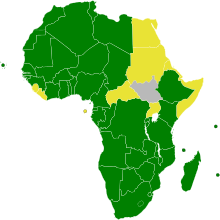Treaty of Pelindaba
| Contract (from) | region | Signatory / ratification |
Year signed / in force |
|---|---|---|---|
| Antarctic Treaty | Antarctic | 45/45 | 1959/1961 |
| Tlatelolco | Latin America / Caribbean | 33/33 | 1967/1968 |
| Rarotonga | South pacific | 13/13 | 1985/1986 |
| Two-plus-four contract | former GDR and Berlin | 6/5 * | 1990/1991 |
| Mongolia Nuclear Weapon Free Zone | Mongolia | 1/1 | 1992/2000 |
| Bangkok | South East Asia | 10/10 | 1995/1997 |
| Pelindaba | Africa | 53 (54) / 40 | 1996/2009 |
| Semei | Central Asia | 5/5 | 2006/2009 |
| * ratified by all still existing contracting parties (the GDR no longer existed) | |||
The Pelindaba Treaty is an international treaty that prohibits the testing, stationing, possession, and manufacture of nuclear weapons in Africa . It was signed by the first states on April 11, 1996 in Pelindaba , South Africa . Such a treaty was already called for at the first official meeting of the Organization for African Unity (OAU) in 1964 . According to Article 21 of the Treaty, the depositary was originally the General Secretariat of the OAU, since 2002 it has been the General Secretariat of its successor, the African Union .
The treaty entered into force on July 15, 2009 when the 28th instrument of ratification was deposited . It was signed by all members of the African Union, with the exception of South Sudan , which has only been independent since 2011 , (a total of 54 states including the Democratic Arab Republic of the Sahara ) and has been ratified by 40 states so far (as of June 2017). These are:
| year | States | |||||
|---|---|---|---|---|---|---|
| 1996 |
|
|
||||
| 1998 |
|
|
|
|
|
|
| 1999 |
|
|
|
|||
| 2000 |
|
|
|
|||
| 2001 |
|
|
||||
| 2002 |
|
|
||||
| 2003 |
|
|||||
| 2005 |
|
|||||
| 2006 |
|
|||||
| 2007 |
|
|
|
|||
| 2008 |
|
|
||||
| 2009 |
|
|
|
|||
| 2010 |
|
|
||||
| 2011 |
|
|||||
| 2012 |
|
|
|
|
||
| 2013 |
|
|||||
| 2014 |
|
|
||||
| 2017 |
|
|||||
In 1996 it became known that the African states of the Arab world would not ratify the treaty until Israel had destroyed all nuclear weapons and allowed controls. Contrary to this statement, Algeria, Libya, Mauritania and Tunisia have already ratified the treaty.
Diego Garcia and the Protocols
The contract contains three protocols. The first protocol can be signed and ratified by the five official nuclear powers and obliges them, among other things, not to use or threaten the use of nuclear weapons vis-à-vis the member states of the treaty and not to contribute to a violation of the treaty. The second protocol is also open to these five states and additionally obliges them not to carry out any nuclear weapons tests in the treaty area or to support such tests. The third protocol concerns France and Spain , which have territories in the treaty territory for which they are de jure or de facto responsible, and if ratified it leads to the application of some essential treaty provisions in these territories as well.
The United Kingdom has ratified the first and second protocols to the treaty, but when signing the protocols expressly stated that it would apply the treaty to the British Indian Ocean Territory , i. H. on Diego Garcia , declines. The US , which uses Diego Garcia as a military base, has also signed but not ratified these two protocols: in May 2011, President Barack Obama passed both protocols to the US Senate with a request for ratification.
Russia refused to ratify the protocols until 2011 because they asked Diego Garcia to be included; Both protocols were ratified in March 2011 with the exception of Diego Garcia, but Russia expressly reserves the right to use nuclear weapons in Africa if Russia itself is attacked with nuclear weapons or if such an attack is imminent if an African state is involved in the attack or an African state has formed an alliance with the attacker against Russia.
The People's Republic of China has signed and ratified the first and second protocols. France has ratified all three protocols, but the third only with reservations. Spain has neither signed nor ratified the third protocol.
Web links
- Current list of contracting parties as well as contract text and protocols on the United Nations website , Office for Disarmament Affairs
Individual evidence
- ↑ Disarmament Treaty Database: Pelindaba Treaty ( English ) United Nations Office for Disarmament Affairs (UNODA). Retrieved June 17, 2017.
- ^ A b Center for Nonproliferation Studies: "African Nuclear-Weapon-Free Zone (Pelindaba Treaty)" (ANWFZ-4), In: Inventory of International Nonproliferation Organizations and Regimes, July 20, 2011, ( online version , accessed January 20 2016).
- ^ Disarmament Treaties Database: Protocol I to the Pelindaba Treaty ( English ) United Nations Office for Disarmament Affairs (UNODA). Retrieved April 19, 2013.
- ^ Disarmament Treaties Database: Protocol II to the Pelindaba Treaty ( English ) United Nations Office for Disarmament Affairs (UNODA). Retrieved April 19, 2013.
- ↑ Disarmament Treaties Database: Protocol III to the Pelindaba Treaty ( English ) United Nations Office for Disarmament Affairs (UNODA). Retrieved April 19, 2013.
